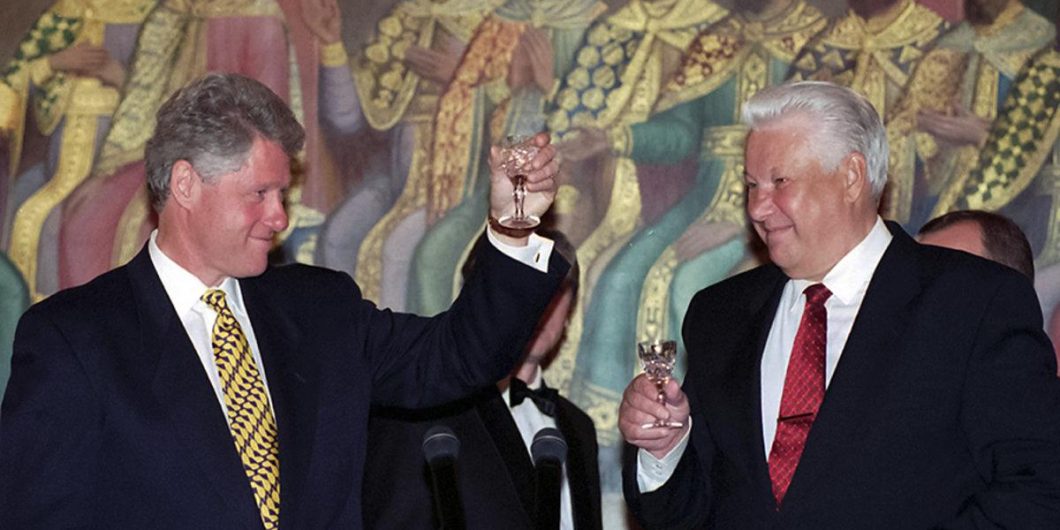American Foreign Policy Through the Ages
In the pages of Promised Land, Crusader State: The American Encounter with the World Since 1776, Pulitzer Prize-winning historian Walter McDougall argues that American foreign policy has been shaped by two broad influences: the impulse to fulfill the promises of democracy and Manifest Destiny at home, and the desire to export the liberal democratic order abroad. In his book, Special Providence: American Foreign Policy and How It Changed the World, Walter Russell Meade claimed that American policy abroad resulted from the constant interplay of nationalist, isolationist, populist, and idealist currents throughout the nation’s history.
In his newest book, The Four Ages of American Foreign Policy: Weak Power, Great Power, Superpower, Hyperpower, Michael Mandelbaum offers a singularly focused argument that American foreign policy was not shaped only by impulses, desires, or ideologies. Instead, Mandelbaum provides readers with a tight conceptual framework that assesses American statecraft in the context of relative international power. The author argues from a realist perspective and claims “the most important condition that determines a country’s foreign policy is the power—economic and especially military power—that it can deploy.” He defines four ages that characterize American foreign policy: Weak Power (1776-1865), Great Power (1865-1945), Superpower (1945-1990), and Hyperpower (1990-2015).
Mandelbaum is well-known as a commentator, author, and expert on American foreign policy. He currently serves as director of the American Foreign Policy program at the Johns Hopkins University School of Advanced International Studies. He previously served as senior fellow at the Council on Foreign Relations. Regarded for more than four decades as one of the leading scholars of American foreign policy, he is the author or co-author of fourteen previous works in this field, including The Rise and Fall of Peace on Earth (2019) and Mission Failure: America and the World in the Post-Cold War Era (2016).
Distinctive American Statecraft
In The Four Ages, Mandelbaum discerns and describes American foreign policy as distinctive from the statecraft of other nations in that it has been “unusually ideological, unusually economic, and unusually democratic.” Mandelbaum describes the ideological basis of American foreign policy as “a spirit of reform, a belief in the possibilities of social and political improvement” that the nation wants to carry beyond its borders. Readers will recognize this as nation-building—an often ill-fated turn in Washington policy making which McDougall derides and Mandelbaum oversimplifies and characterizes as the idealist (as opposed to realist) strain of American foreign policy. Meade’s assessment is more nuanced; he recognizes idealism as a constant current that tugs at policy decisions.
Mandelbaum takes a far too narrow view of America’s “repeated recourse to the use of economic leverage to pursue” its foreign policy goals. He characterizes them as either “sanctions” or “the export of capital.” McDougall, however, sees this economic aspect of foreign policy as more expansive, incorporating policies as diverse as tariffs, foreign aid, and multilateral trade agreements—all of which he regards as having dubious, or at best, transitory value.
According to Mandelbaum, America’s democratic character also meant that “a wide range of groups, individuals, and viewpoints has been able to influence policy-makers” throughout the nation’s history. Multiple points are open to Americans to shape the nation’s foreign policy: the Executive, the Congress, the press, special interest groups, and the force of public opinion bolstered by a Constitutional right to speak, assemble, and petition.
In these ways the United States differs from the great powers of Europe, in which a small circle consisting of the monarch and the aristocracy typically dominated foreign policy. The United States had neither and so lacked as well the culture of deference that they tend to foster. From the very beginning, American citizens, unlike their European counterparts, exercised major influence over their country’s activities abroad. While the American government has often had broad latitude to conduct the nation’s foreign policy, and has occasionally done so secretly, in general public sentiment has weighed more heavily upon it than has been customary in other countries.
Foreign Policy History
In a sweeping account covering more than 200 years of American history, Mandelbaum offers readers a clear and compelling narrative with sufficient context to provide insight and nuance, without belaboring detail. For example, Mandelbaum makes the case that American foreign policy has never been isolationist in nature. He briefly recounts the period 1939-1941 as an unusual period of intense noninterventionism when a broad and formidable movement formed to oppose U.S. entry into the European war. In one of many keen insights offered throughout the book, the author notes that “unlike other wars (in American history), the sharpest controversy and strongest opposition came before the country declared war” following the attack on Pearl Harbor, which unified public sentiment and galvanized Congress.
Mandelbaum also furnishes readers with savvy assessments of the key actors and their actions that shaped American foreign policy during pivotal periods in the nation’s history. For example, he provides solid elaboration and a balanced evaluation of Roosevelt’s pre-war commitments to Britain, his support of China, and the economic embargo of Japan as effective interim policies. Deliberate and thoughtful, the author also offers an incisive assessment of the carefully orchestrated policy of détente developed by Nixon and Kissinger at the height of the seemingly intractable Cold War.
Mandelbaum’s broad conceptual framework leaves little or no room for the vagaries of history and American foreign policy making.
The Four Ages of American Foreign Policy is not an unabashed admirer’s paean to the effectiveness of American foreign policy across the ages, however. Like McDougall and Meade, Mandelbaum makes a case for the remarkable achievements of American foreign policy. “Before the 1990s, through many twists and turns, the American international initiatives had enjoyed remarkable success,” he writes. “The foreign policy of the American hyperpower did not.”
Mandelbaum, for example, is critical of the Clinton Administration’s understanding of the role of the nation as a hyperpower. He cites limp policies that hinged on globalization to advance U.S. interests abroad—especially of the Clintons’ failed “enlargement of the world’s community of market democracies”—and the expectations that engagement with China would encourage that nation to embrace liberal democracy. This is hardly surprising. Mandelbaum’s book, The Dawn of Peace in Europe (1996), was an unalloyed critique of Clinton foreign policy.
The author also drily notes that America’s humanitarian efforts in the 1990s “failed to transform the places where it intervened.” Mandelbaum argues the expansion of NATO was a huge misstep and quotes George Kennan who called it “the most fateful error of American foreign policy in the entire post-Cold War era,” an error that inevitably made Moscow’s opposition to Washington’s global initiatives “default Russian policy.”
Conceptual Limitations
The Four Ages of American Foreign Policy, for all its merits, fails to make a wholly convincing case for viewing American policy solely through an epochal lens. That’s because Mandelbaum’s broad conceptual framework leaves little or no room for the vagaries of history and American foreign policy making. During the Post-Revolutionary period, for example, the author argues the United States was in its first age as a weak power. In Mandelbaum’s approach, the weak power United States was, by definition, militarily and economically constrained and ideologically disposed to shape statecraft to avoid competition with more powerful nations. Conceptually, this explains the Embargo Act which prohibited exports during the Napoleonic Wars, and the later Non-Intercourse Act intended to safeguard American neutrality, both of which were passed by a Congress eager to avoid war. But the weak power conceptual approach provides no explanation for the War of 1812, when the Congress voted to go to war with Great Britain—despite broad public opposition—then one of the most powerful nations in the world.
In addition, the rigid dates that accompany each age of American power as Mandelbaum shapes them, simply don’t square with history. For example, the author defines the third age when America rose to the status of other Great Powers (largely European) as beginning with the end of the American Civil War in 1865. At that time European nations were equipping huge standing armies (more than 1.5 million were deployed in the Franco-Prussian War in 1870) and modernizing their navies by building ironclad warships. The United States had fully disbanded a million-man army and reduced it to less than 43,000 troops by 1871. In 1880, the U.S. Navy had a fleet of 48 wooden ships of sail and shore facilities best described as decrepit. A better argument could be made that the United States did not achieve Great Power status until it built and proved the capabilities of a two-ocean navy in the Spanish American War (1898).
Despite the limits of his conceptualizations, Mandelbaum’s book is a thoughtfully written and welcome contribution to the study of American foreign policy that takes its place beside the studies of McDougall and Meade and their approaches to an analysis of American foreign policy. Mandelbaum offers readers an engaging book of measured appraisals, devoid of revisionism, and absent partisan leanings. It is admirably balanced and a welcome book of very good historical writing. Lucid, insightful, and engaging, The Four Ages of American Foreign Policy will have enormous appeal both for scholars in the field and for the general reader.


